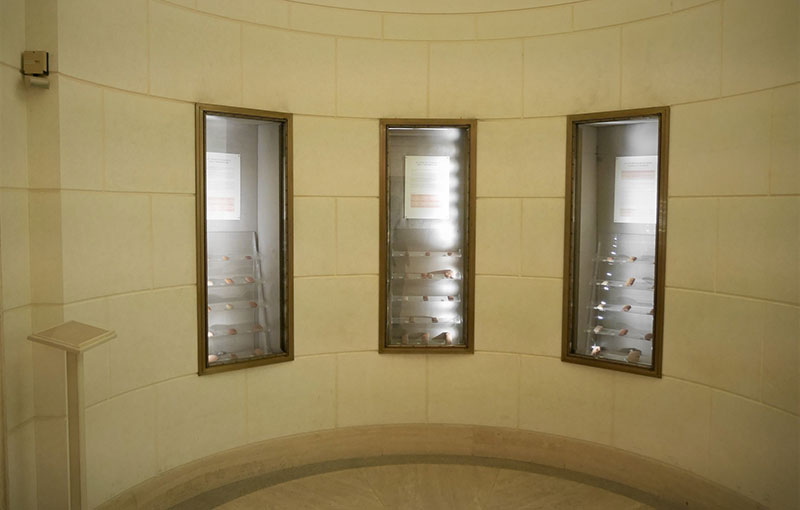
Vetrina 1 (sinistra)
L'invenzione della scrittura in Mesopotamia
La prima civiltà urbana risale alla fine del quarto millennio a.C. in Mesopotamia, la "terra tra i due fiumi" Tigri e Eufrate: l'odierno Iraq. Qui, l'umanità vede la nascita della prima città (Uruk) e della scrittura.
Con l'invenzione della scrittura circa nel 3200 a.C., l'uomo esce dalla preistoria e inizia a narrare gli avvenimenti. I Sumeri scrissero su tavolette d'argilla, usando dapprima pittogrammi e poi caratteri cuneiformi, per oltre tremila anni. Stili con punte acuminate o smussate, e più tardi con sezioni triangolari, erano usati per incidere le tavolette d'argilla, che venivano poi cotte al sole o, più raramente, al forno per una migliore conservazione.
Negli ultimi 150 anni gli scavi degli archeologi hanno portato alla luce centinaia di migliaia di tavolette dei tre millenni prima di Cristo. In gran parte (dal 70 all'80 per cento) riguardano argomenti quali documenti contabili o amministrativi, registrazioni di spedizioni e consegne di merci, vendita di terreni, schiavi e altre merci, affitti, salari, multe, prestiti, interessi dovuti, debiti e loro cancellazioni, sanzioni penali, matrimoni, divorzi, donazioni, adozioni, vertenze di ogni genere per i verdetti delle corti, eredità, e così via, in una complessa trama di attività amministrative, economiche e legali.
Vetrina 2
La collezione di tavolette mesopotamiche della Banca d'Italia
La Banca d'Italia possiede un'importante collezione di tavolette d'argilla della Mesopotamia.Il loro studio fa progressivamente emergere che fin dal terzo millennio a.C. l'argento e l'orzo (e in minor misura il rame, lo stagno, talvolta l'oro o altre merci) fungevano da mezzi di pagamento, misura di valore e riserva di ricchezza.
I popoli mesopotamici facevano prestiti in argento o orzo, a tassi di interesse fissati per legge - sotto le leggi di Ana-Ittisu (fine del terzo millennio), il codice di Esnunna (circa 1800 a. C.) e il codice di Hammurabi (18 secolo a.C.) - al 20 per cento per l'argento e al 30 per cento per l'orzo.
Tuttavia, numerose tavolette dimostrano che gli interessi applicati avrebbero anche potuto essere più alti o più bassi di quelli legali. A partire dal terzo millennio troviamo casi di usura, combattuti attraverso la remissione dei debiti e la liberazione di coloro che, falliti per pagare i debiti, venivano resi schiavi.
Vetrina 3 (destra)
Prestito in argento
Questo prestito (cfr. foto n.I.9) d'argento, databile al 1800 a.C., proviene da una sconosciuta città che deve essere a sud di Bagdad. Il calcolo dell'interesse avviene nel seguente modo: 1 siclo (= 8,3 gr) contiene 180 grani; 1/6 di siclo è quindi di 30 grani; ad essi si aggiungono ulteriori sei grani, ottenendo così 36 grani, ovvero il 20 per cento di 1 siclo. Il 20 per cento costituiva la regola per l'interesse sui prestiti in argento, mentre invece per i prestiti di orzo esso era del 30 per cento.
Si può quindi ritenere che fossero più rischiosi i prestiti di orzo, un bene fondamentale per la sussistenza, che veniva prestato a gente povera, mentre l'argento costituiva il mezzo di pagamento usuale per i mercanti.
Nel contratto in esame, l'argento è preso in prestito da una donna, Amurritum: è davvero eccezionale che sia una donna a ricevere un prestito di argento. Forse ella - essendo una serva - lo ha contratto per conto di Ikun-pi-Istar.
Come i popoli islamici di oggi, i Babilonesi impiegavano un calendario lunare, la cui durata differisce da quello solare: essi quindi da secoli usavano un secondo mese XII (mese intercalare) per riequilibrare i due cicli. Si potrebbe pensare a un XIII mese. Il prestito vale per tre mesi dal XII al III dell'anno successivo, periodo che corrisponde alle operazioni di mietitura. Forse si era verificato un difetto di orzo nel XIII mese.


 YouTube
YouTube  X - Banca d’Italia
X - Banca d’Italia  Linkedin
Linkedin 